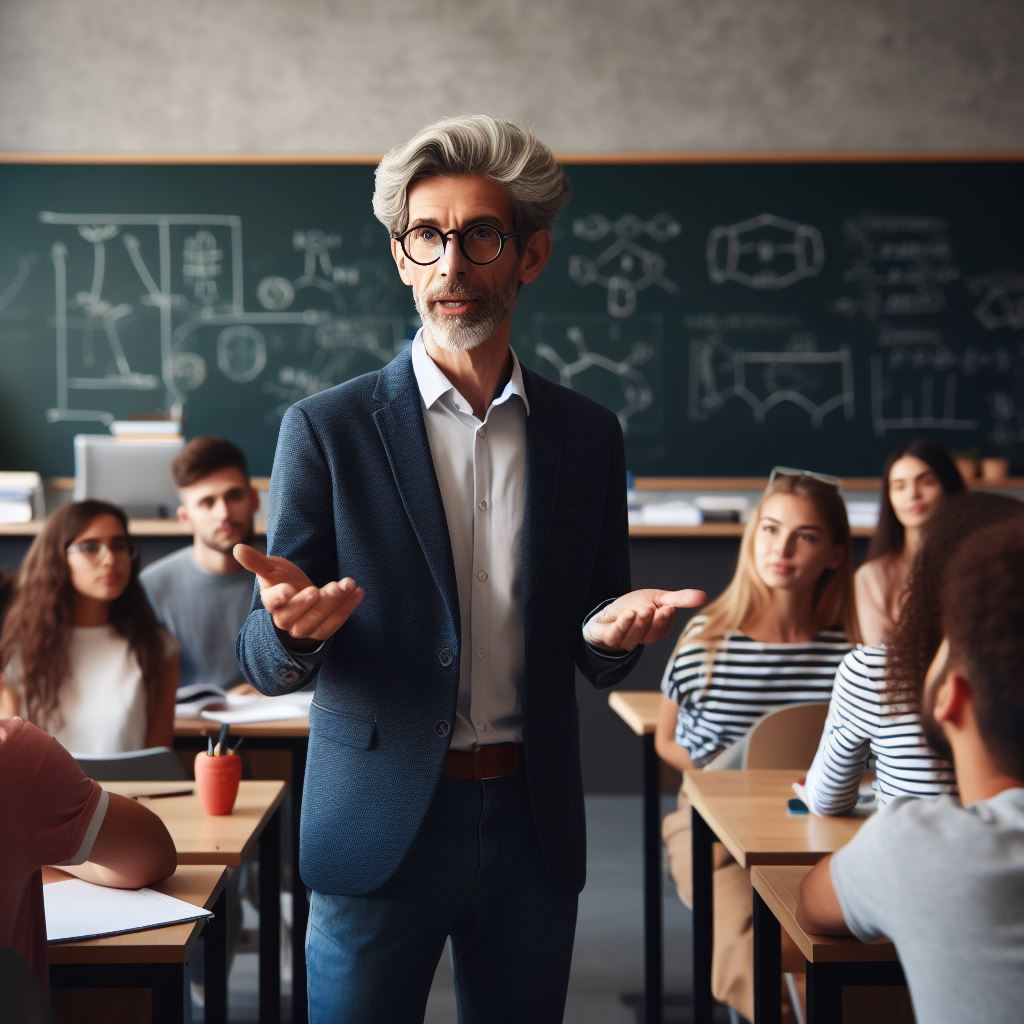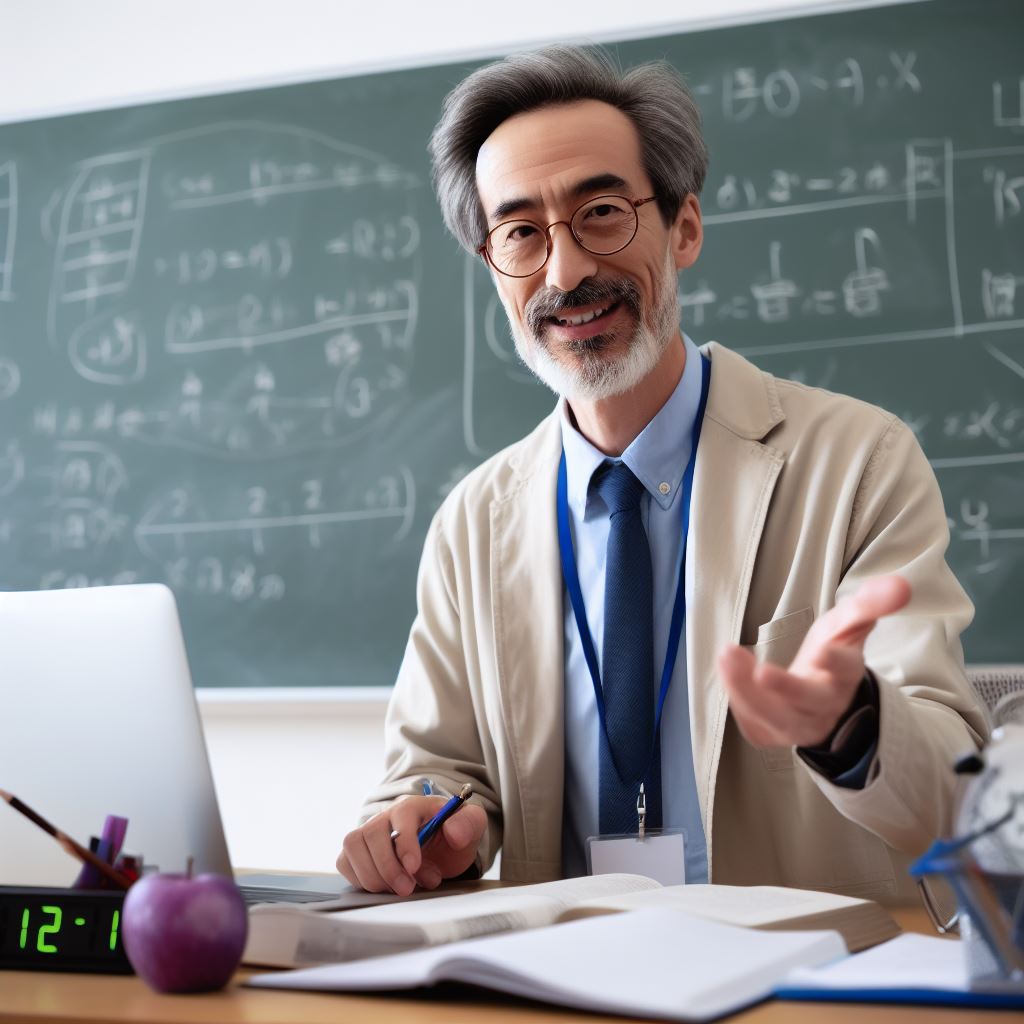Introduction
Effective teaching strategies play a crucial role in shaping education, and top US professors are at the forefront of implementing them.
As educators, it is essential to understand the significance of employing effective teaching strategies.
Top US professors pave the way for innovative and impactful education by embracing these strategies.
By actively implementing them, they enhance the learning experience for students across the nation.
The significance of effective teaching strategies is paramount.
Top US professors empower and inspire through interactive methods like problem-based learning, group discussions, and technology integration.
They create an environment fostering critical thinking, collaboration, and creativity, ensuring students gain valuable skills for the future.
Furthermore, creating a positive and inclusive classroom culture is instrumental in effective teaching.
Top US professors cultivate an environment that values diversity, promotes respect, and encourages active participation.
By fostering open dialogue, providing constructive feedback, and recognizing individual strengths, educators create a supportive environment for student success.
The impact of effective teaching strategies employed by top US professors cannot be underestimated.
By actively embracing and implementing these strategies, educators shape the future of education.
By integrating technology, fostering an inclusive classroom culture, and using interactive learning methods, educators equip students for success in a rapidly evolving world.
Active Learning Techniques
Definition of active learning
Active learning is an approach where students are actively engaged in the learning process, rather than passively receiving information from the professor.
Examples of active learning strategies used by top US professors
- Group discussions: Professors encourage students to discuss concepts and ideas with their peers, fostering collaboration and critical thinking.
- Problem-solving activities: Professors assign real-life problems for students to solve, allowing them to apply their knowledge in practical situations.
- Case studies: Professors present real or hypothetical scenarios for students to analyze and come up with solutions, promoting problem-solving skills.
- Simulations and role-playing: Professors create scenarios where students take on specific roles, enabling them to experience real-world situations.
- Peer teaching: Professors assign students to teach a particular topic to their classmates, fostering knowledge consolidation and communication skills.
- Interactive technology: Professors incorporate interactive technology tools, such as online quizzes or educational games, to enhance student engagement.
- Hands-on experiments: Professors provide opportunities for students to conduct experiments, allowing them to learn through a hands-on approach.
Benefits of active learning for students
- Increased engagement: Active learning techniques stimulate students’ curiosity and motivation, leading to a higher level of engagement in the classroom.
- Improved critical thinking skills: Through active learning, students are encouraged to think critically, analyze information, and develop their own opinions.
- Enhanced retention of information: Active learning enhances understanding as students engage in the learning process, improving knowledge retention.
- Better problem-solving abilities: Active learning strategies let students practice problem-solving, enhancing proficiency in identifying and solving problems.
- Development of teamwork and communication skills: Collaborative activities in active learning foster teamwork and improve communication skills among students.
- Increased confidence: Active learning strategies allow students to actively contribute to discussions, share their ideas, and gain confidence in their abilities.
- Preparation for real-life situations: Active learning prepares students for real-world scenarios by encouraging them to take an active role in their education.
How professors incorporate active learning in the classroom
- Flipped classrooms: Professors assign readings or pre-recorded lectures for students to review before class, allowing class time to be focused on discussion and application.
- Collaborative projects: Professors assign group projects, promoting active learning as students collaborate to analyze, research, and present findings.
- Socratic seminars: Professors engage students in guided discussions by asking open-ended questions, encouraging active participation and critical thinking.
- Think-pair-share: Professors pose questions, students reflect individually, discuss with a partner, and share thoughts, fostering active engagement and collaboration.
- Just-in-time teaching: Professors collect students’ responses to pre-class readings or assignments and use them to tailor the in-class activities or discussions accordingly.
- Multiple assessment methods: Professors use diverse assessments, like quizzes and group projects, fostering engagement and active learning in the classroom.
In fact, active learning techniques play a crucial role in effective teaching strategies adopted by top US professors.
Active student involvement enhances engagement, critical thinking, retention, problem-solving, teamwork, and communication skills.
Professors, through innovative approaches, create an environment for holistic student development, preparing them for real-life situations.
Read: Handling Crisis: The Role of a Counselor in Emergencies
Engaging and interactive lectures
Importance of keeping students engaged during lectures
Engaging and interactive lectures are crucial for effective teaching. It is essential to keep students actively involved and interested in the subject matter.
Strategies used by top professors to make lectures interactive
Top professors employ various strategies to make lectures interactive and ensure maximum engagement.
Transform Your Career Today
Unlock a personalized career strategy that drives real results. Get tailored advice and a roadmap designed just for you.
Start Now- Firstly, professors understand the importance of creating a stimulating learning environment.
- They utilize techniques such as using real-life examples, incorporating multimedia tools, and sharing personal experiences.
- These strategies help students relate to the content and maintain their interest throughout the lecture.
- Lectures become interactive when students actively participate. Professors encourage discussions, ask open-ended questions, and promote critical thinking.
- They create opportunities for collaboration among students by assigning group activities or debates.
- Such activities enhance student engagement and foster deeper learning.
Incorporation of multimedia tools and technology
Technology plays a significant role in making lectures interactive. Professors use multimedia tools like PowerPoint presentations, videos, and interactive simulations.
These tools help illustrate complex topics, cater to different learning styles, and capture students’ attention.
By incorporating technology, professors enhance the overall learning experience.
Another strategy employed by top professors is the incorporation of active learning techniques.
Rather than being passive recipients of information, students are encouraged to become active participants.
Professors use techniques like case studies, problem-solving exercises, and hands-on experiments.
These activities promote critical thinking, engagement, and application of learned concepts.
Ways to encourage student participation and discussion
- To encourage student participation and discussion, professors create a supportive and inclusive classroom environment.
- They establish clear expectations and provide feedback. Professors also allocate time for questions, allowing students to seek clarification or share their insights.
- This interaction fosters a sense of involvement and encourages students to actively contribute to the lecture.
- Professors also recognize the value of incorporating real-world examples and relevance into their lectures.
- They connect the subject matter to students’ lives, showcasing its practical applications and importance.
- By doing so, they engage students and demonstrate the relevance of the material, enhancing their motivation to learn.
In short, engaging and interactive lectures are essential for effective teaching.
Top professors employ various strategies, including utilizing multimedia tools, encouraging student participation, and incorporating active learning techniques.
By creating an interactive learning environment, professors enhance student engagement, foster critical thinking, and promote deeper understanding of the subject matter.
Read: School Counselors and College Admissions: A Deep Dive

Real-world application of knowledge
Effective teaching goes beyond the confines of the classroom, as top US professors understand the value of connecting classroom lessons to real-life scenarios.
This section explores the methods employed by professors to relate concepts to practical situations, including the utilization of case studies, projects, and simulations.
We also delve into the benefits of real-world application for student learning and retention.
Value of connecting classroom lessons to real-life scenarios
One of the most effective teaching strategies embraced by top US professors is the ability to link classroom lessons to real-life scenarios.
By doing so, they enable students to see the practical applications of what they are learning and understand how it can be applied in their future careers.
When students can relate what they are learning to real-life situations, they become more engaged and motivated.
It helps them see the relevance of the subject matter, leading to improved learning outcomes and increased retention of knowledge.
Methods employed by professors to relate concepts to practical situations
Professors use various methods to bridge the gap between theoretical concepts and practical applications.
Showcase Your Business Today
Reach thousands of readers actively exploring professional services. Publish your business profile and grow your audience now.
Publish NowA common approach involves case studies, where students analyze real-life scenarios and apply knowledge to solve professional problems.
Another effective method employed by professors is through projects.
By assigning practical projects related to the subject matter, students are given the opportunity to apply their theoretical knowledge in a hands-on manner.
This fosters critical thinking, problem-solving, and creativity.
Simulations are another valuable tool that professors utilize to create real-world environments in the classroom.
Through simulations, students can experience scenarios they might encounter in their future professions, enhancing their understanding and skill development.
Utilization of case studies, projects, and simulations
The incorporation of case studies, projects, and simulations in teaching brings immense benefits to students.
Case studies immerse students in realistic situations, forcing them to apply their critical thinking and decision-making skills.
Projects require students to take ownership of their learning, develop time management and teamwork skills, and apply their knowledge to solve real problems.
These hands-on experiences foster a deeper understanding of the subject matter and encourage students to think outside the box.
Simulations provide a safe environment for students to experiment, make mistakes, and learn from them.
They allow students to practice skills and gain confidence before entering real-world situations.
Students can explore different scenarios, test theories, and receive immediate feedback, facilitating their overall learning process.
Benefits of real-world application for student learning and retention
- The real-world application of knowledge has numerous benefits for student learning and retention.
- When students can see the practical relevance of what they are learning, they are more motivated to engage and learn deeply.
- This, in turn, leads to better retention of knowledge.
- Real-world application also helps students develop transferable skills that are crucial in their future careers.
- They gain critical thinking, problem-solving, and decision-making abilities that can be applied beyond the classroom setting.
- This prepares them to be successful in the professional world and adapt to new challenges.
In essence, top US professors recognize the importance of connecting classroom lessons to real-life scenarios.
Through the utilization of case studies, projects, and simulations, they enable students to apply their knowledge in practical situations.
This not only enhances learning outcomes but also equips students with valuable skills for their future careers.
Read: Networking in Academia: How US Professors Collaborate
Personalized and individualized instruction
Recognition of diverse student needs and learning styles
ersonalized and individualized instruction is a key component of effective teaching strategies adopted by top US professors.
These educators recognize that students have diverse needs and learning styles, and they tailor their instruction to accommodate these differences.
Strategies used by professors to tailor instruction to individual students
One of the strategies used by professors to personalize instruction is to get to know their students on a personal level.
They take the time to understand each student’s background, interests, and learning preferences. This helps them design lessons that are relevant and engaging for each individual.
In addition to understanding their students, professors also use a variety of methods to tailor instruction.
They may use different teaching techniques, such as lectures, group discussions, hands-on activities, or multimedia presentations, to cater to different learning styles.
They also provide students with multiple opportunities to demonstrate their knowledge and skills, such as through tests, projects, presentations, or portfolios.
Importance of providing constructive feedback and support
- Another important aspect of personalized instruction is providing constructive feedback and support.
- Professors understand that feedback is crucial for students to improve their understanding and performance.
- They provide specific and timely feedback that highlights areas of strength and areas for improvement.
- They also offer guidance and support to help students overcome challenges and reach their full potential.
Flexible teaching methods to cater to varied abilities and interests
- Flexible teaching methods are also employed by top professors to cater to the varied abilities and interests of their students.
- They offer choices within assignments and allow students to pursue topics that align with their passions.
- This not only enhances student engagement but also promotes independent and critical thinking.
Top US professors create an inclusive and supportive learning environment by personalizing instruction.
Recognizing students’ unique qualities fosters motivation and active participation, aiding in the development of skills like self-awareness and self-regulation.
Basically, personalized and individualized instruction is a vital aspect of effective teaching strategies employed by top US professors.
It involves recognizing the diverse needs and learning styles of students and tailoring instruction to accommodate these differences.
By providing constructive feedback, utilizing flexible teaching methods, and promoting student choice, professors create an inclusive and supportive learning environment.
This approach not only enhances student engagement and motivation but also fosters the development of important skills for success in both academia and beyond.
Use of innovative technology
Technology has become an integral part of our lives, and its presence in education is no exception.
In today’s rapidly changing world, teachers are constantly seeking innovative ways to make learning more engaging and interactive for their students.
This blog section explores the effective teaching strategies adopted by top professors in the US through the use of innovative technology.
Integration of technology as a means to enhance teaching and learning
- One vital aspect to consider is the integration of technology as a means to enhance teaching and learning. Gone are the days of traditional lecture-style classes.
- Professors recognize the importance of integrating technology tools for a dynamic and immersive learning experience.
Examples of technology tools and resources utilized by top professors
Top professors in the US use various technology tools and resources to enhance student learning.
For instance, they utilize interactive whiteboards and projectors to display multimedia content, engage students visually, and stimulate critical thinking.
Likewise, they use digital simulations and VR to bring abstract concepts to life, giving students a firsthand, deeper understanding.
Advantages of technology in increasing student engagement and collaboration
The advantages of integrating technology in the classroom are numerous. First and foremost, it increases student engagement.
Traditional teaching methods often fail to capture students’ attention, leading to disinterest and apathy.
By incorporating technology, professors can create interactive lessons that appeal to different learning styles, making the learning process more enjoyable and engaging.
Technology also promotes collaboration among students.
Showcase Your Business Today
Reach thousands of readers actively exploring professional services. Publish your business profile and grow your audience now.
Publish NowThrough online platforms and communication tools, students can collaborate on projects, share resources, and engage in discussions outside the physical classroom.
This not only enhances their social and communication skills but also prepares them for the collaborative nature of the professional world.
However, implementing technology effectively requires careful considerations.
One crucial aspect is ensuring that the selected technology aligns with the learning objectives and curriculum.
Professors must understand the specific needs of their students and choose tools that enhance the desired learning outcomes.
Considerations for effective implementation and potential challenges
- Additionally, professors need to provide adequate training and support to both themselves and their students.
- Learning new technology tools can be intimidating for some students, so clear instructions and ongoing guidance are essential for their successful adoption.
- Similarly, professors must invest time in exploring and familiarizing themselves with the potential of different technologies to ensure effective implementation.
- While technology offers immense benefits, it also presents potential challenges.
- Technical glitches or connectivity issues can disrupt the flow of a class, leading to frustration and wasted time.
- Professors need to have contingency plans in place and be prepared for such situations to minimize disruptions.
- Another challenge is maintaining a balance between technology use and traditional teaching methods.
- While technology can enhance learning, it should not replace essential human interaction and face-to-face communication.
- Professors need to strike the right balance and utilize technology as a tool to support and enrich their teaching, rather than relying solely on it.
Generally, the use of innovative technology in teaching has revolutionized the way professors engage with their students.
Top US professors enhance engagement, promote collaboration, and create immersive learning experiences by integrating technology tools and resources.
However, effective implementation requires thoughtful consideration of the learning objectives, adequate training, and preparation for potential challenges.
Ultimately, technology should be seen as a valuable aid that enhances traditional teaching methods rather than replacing them entirely.
Read: The Impact of Student Evaluations on US Professor Careers
Conclusion
This blog section discussed the effective teaching strategies adopted by top US professors.
We have learned that these strategies include active learning, real-world application, and personalized instruction.
Continuous professional development is crucial for educators to stay updated with the latest teaching techniques and enhance their skills.
By incorporating these strategies into their teaching practices, educators can create a more engaging and effective learning environment for their students.
It is important for all educators to embrace these strategies and strive for continuous growth in order to provide the best education possible.
[E-Books for Sale]
The Big Book of 500 High-Paying Jobs in America: Unlock Your Earning Potential
$19.99 • 500 High-Paying Jobs • 330 pages
Explore 500 high-paying jobs in America and learn how to boost your career, earn more, and achieve success!
See All 500 High-Paying Jobs of this E-Book
1001 Professions Without a Degree: High-Paying American Jobs You Can Start Now
$19.99 • 1001 Professions Without a Degree • 174 pages
Discover 1001 high-paying jobs without a degree! Unlock career tips, skills, and success strategies for just $19.99!




